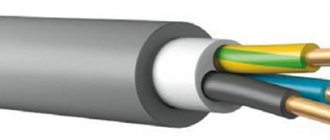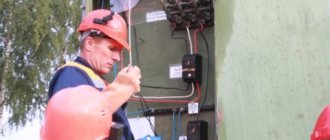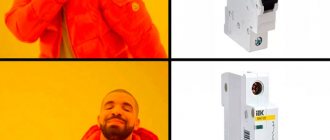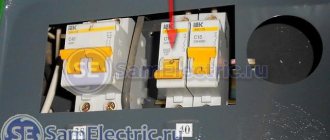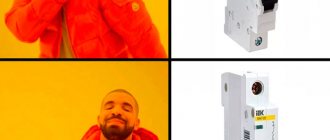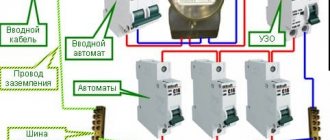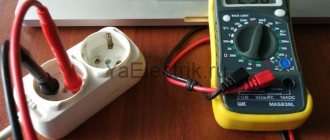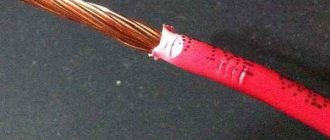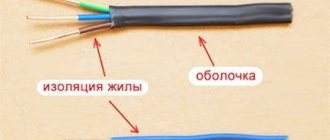When installing an electrical network in a private house or apartment, it is important to select the correct circuit breakers for each line based on the power of the connected electrical appliances. All of these protective devices are usually installed in the electrical panel and provide protection against overload or short circuit. But if all these devices protect the lines to the electricity consumer, then a device is needed that will protect a group of circuit breakers in the switchboard. Such a device is the so-called “input” machine.
Design and principle of operation
Externally, the device is similar to a conventional protective device that is installed in the distribution panel.
The main difference from other means of protection is the large rated current. Elements:
- solenoid;
- bimetallic strip.
When a short circuit occurs, the current increases rapidly. A powerful magnetic field is generated in the solenoid coil, due to which the core is pulled inward and the circuit breaks.
The machines differ in the number of poles, rated current, power consumption, and phases of the power supply.
Inrush currents are reduced
Most manufacturers are aware of the harm and dangers that inrush current brings. Here's what they do to reduce it:
- An NTC thermistor (thermistor) is installed at the power input of electronic devices, which, due to its physical properties, has a high resistance in a cold state. Of course, this is not a panacea, and there are restrictions on their use associated with a decrease in the efficiency of the device as a whole.
- Inverter power supply for soft start. By this I mean powering the motors through semiconductor starters. Frequency converters, soft starters and the proud inscription Invertor are from this opera.
- Delayed power supply via relay. In this case, at the beginning, part of the power is supplied, and after a split second - 100%. I wrote about this above and gave the example of the MRP relay.
- An increase in cos φ and a decrease in harmonics and the reactive component of the supply current also contribute to the overall cause.
Fortunately, inrush currents, unlike rated currents, in most cases do not act simultaneously. If you turn on the power in an apartment, it is better not to do it through the main (input) switch. The rule of good manners is to supply power sequentially, turning on group machines one after another.
Types
The machine is selected taking into account the electrical network diagram and its needs. There are single-pole, two-pole, three-pole and four-pole devices.
Single pole
A single-pole switch is used in single-phase electrical networks. Different models have different characteristics, which determine the shutdown speed. The composition includes two release mechanisms - electromagnetic and thermal.
One is triggered when there is a short circuit, the second when the load is exceeded for a certain time. It is connected through the upper terminal, the outgoing wire is connected to the lower one. The principle of operation is the same as that of diverter machines, but the current rating is higher.
Bipolar
Used in single-phase input. The design consists of a block with two poles, which are equipped with levers and a common lock between the shutdown mechanisms. That is, the main difference from a single-pole network is that if there is a problem on any of the lines coming from it, both will be disconnected. Two-terminal networks are used in typical modern apartments.
You cannot replace one double-pole switch with two single-pole circuit breakers! This is prohibited by the PUE.
Three-pole
For three-phase networks, three-terminal and four-terminal networks are used. Such electrical networks are found in homes where food is cooked on electric stoves. To connect a three-pole circuit breaker, each terminal is connected in phase. In devices with four poles, a neutral wire is additionally used.
When installing it yourself, the ground (not the neutral) should never pass through the machine.
Electrical panel for a cottage/garage - clear, simple, for everyone
(The article was written by my son Qirex-RD for my blog at the request of my readers.)
In the previous article on electrics (Car service electrics - fast, correct, cheap) I showed how I did everything on a budget but with high quality in a 3-phase small-scale industrial network . After which there were requests in the comments to tell more. It is logical to do this using the example of apartment/country/garage electrics. Well, actually, here it is...)))
Summer has come and many people have a problem with the safe supply of electricity to their dachas. What exactly is the matter here? Well, for example, if you do it wrong, the dacha will burn down, and it’s good if it doesn’t happen to you. But there is a nuance here... Dachas are mainly located on SNT lands, i.e. where, by definition, there is no control over anything. Accordingly, these local specialists are usually armless drunks. Also, SNT is always a reserve of price chaos, where prices are 3 times higher than in the capital of Russia, and the quality is only at the level of a barn (applies to everything related to construction). Because This article is directly about the electrical panel, we won’t touch on prices for wiring, but the panel... The typical thing you will get for 5000-7000 rubles from a local electrician is three cheap, somehow screwed-on machines, with the proud name - electrical panel (correctly - electroshit).
Those. This is exactly the case when it is better to do it yourself than to entrust it to an unverified 3rd party who calls himself an electrician but in fact is not even close to one. Thus, everything will be done much better and more reliably, and a lot of money will also be saved (in fact, the price of the entire shield!).
How did this article come about?
A video blogger I know near Yaroslavl is building himself a budget mini-house. He tries to pretend to be a beggar, but he’s not very good at it, either he’ll order expensive windows or he’ll refuse to assemble the shield for the iEK. A wasteful rogue in short.))) During construction, he naturally needed a simple single-phase electrical installation. He didn’t even try to find hired electricians, because he obviously became disappointed in them after looking at other people’s panels, which, unfortunately, is a completely standard situation for Russia, regardless of the region (90% of electricians are rednecks). As a result, he decided to do everything himself, without having any experience or knowledge. Naturally he turned to me for advice. What you see now is essentially the instructions that I wrote for him. For you, I will show all this clearly using the same components, so that if you wish, you can easily assemble the same one for yourself.
!Everything you do yourself is done at your own peril and risk, only you are responsible for all this! Remember about electrical safety (refer to relevant literature) and use common sense!
Terms of reference (TOR):
— high degree of protection and reliability — simple and quick implementation (without special tools) — low budget
Well, everything is more than clear, we’re doing it!
Schneider Electric Easy 9 for 12 modules. High quality, cheap, easy to use, everything you need is included.
Source
Automatic input calculation
Before purchasing a machine, it is important to calculate it correctly.
Characteristics:
- number of poles;
- time-current characteristic;
- rated current;
- installed capacity;
- rated leakage current;
- line voltage;
- selectivity;
- maximum short circuit current.
The current rating is determined for the simultaneous connection of all electrical appliances to the network. Power also depends on current.
Powerful devices such as water heaters and electric stoves are equipped with additional input circuit breakers.
Machines for TN-S and TN-C systems are used. In the first case, a single-terminal network with a zero or a two-terminal or three-terminal network with a neutral is selected. In the second case, you need a single-pole (for a 220 V network) or a three-pole (for 380 V) circuit breaker.
Calculation for a 220 Volt apartment electrical network
The input circuit breaker into an apartment with a voltage of 220 V is calculated using the following formula:
Ip=Pp/(Uф*cosф). In this formula, Uph is the phase voltage, Рр is the calculated power, Ip is the load current. Cosф is a dimensionless quantity characterizing the presence of reactive power.
Calculation for a 380 Volt apartment electrical network
To calculate a switch for a 380 V power supply, the formula is slightly modified:
Ip=Pp/(Un*cosph). Un is the network voltage.
When choosing a device, the rated current should be increased by 10% for reserve.
Price
Opponents of “B” machines argue that the price of electrical panels can skyrocket. And you won’t find such devices for sale. Their fears are easily dashed by facts. Here is a comparison table for machines “B” and “C” of two brands of opposite quality (according to information from a well-known online store):
Comparison of prices of machines “B” and “C”
Does a 5-10% price difference really matter?
Not available? I don’t know about you, but in my province the necessary modular equipment is available in a wide range.
VA selection
In addition to the main selection criteria, there are additional ones. These include neutral mode, current frequency and line voltage.
Neutral mode
Simply put, neutral mode is the way a home is grounded. Traditionally, homes feature a TN system with various variations. The most common ones include TN-C, TN-CS and TN-S.
The TN-S system has supply neutral and working wires, which are separated from the substation to the energy consumer. The TN-C system consists of combined supply neutral and working wires.
Current frequency
One of the main parameters of the electrical network is the current frequency.
This is the number of complete cycles of change in EMF (electromotive force) in one second. For the Russian Federation this value is 50 Hz. Simply put, the current flows 50 times per second in one direction and 50 times in the other, passing through the zero value 100 times. For example, an ordinary light bulb connected to a network with a frequency of 50 Hz will flare up and go out 100 times per second.
Line voltage value
For Russian power grids, voltage is a fixed value. Equals 220 V or 380 V + - reserve. Linear is the voltage between two phases, which is 60% greater than the phase voltage. And accordingly = 380V.
Selecting the breaking capacity
The selection of a packager based on the maximum permissible load current is described above. But the network circuit breaker must also turn off when a short circuit (short circuit) occurs in the network. This characteristic is called breaking capacity. It is displayed in thousands of amperes - this is the order currents can reach during a short circuit. Selecting a machine based on its breaking capacity is not very difficult.
This characteristic shows at what maximum value of the short-circuit current the circuit breaker remains operational, that is, it will not only be able to turn off, but will also work after being turned on again. This characteristic depends on many factors and for accurate selection it is necessary to determine the short-circuit currents. But for wiring in a house or apartment, such calculations are done very rarely, and are based on the distance from the transformer substation.
Breaking capacity of automatic protective switches
If the substation is located close to the entrance to your house/apartment, take a circuit breaker with a breaking capacity of 10,000 A; for all other city apartments, 6,000 A is enough. If the house is located in a rural area or you are choosing a circuit breaker for a summer residence, it may well be enough and a breaking capacity of 4,500 A. The networks here are usually old and short-circuit currents are not large. And since the price increases significantly with increasing breaking capacity, the principle of reasonable savings can be applied.
Is it possible to install bags with a lower breaking capacity in city apartments? In principle, it is possible, but no one guarantees that after the first short circuit you will not have to change it. He may have time to turn off the network, but will be inoperative. In the worst case scenario, the contacts will melt and the machine will not have time to turn off. Then the wiring will melt and a fire may occur.
Installation
The main type of mounting of machines is installation on a DIN rail. The devices are not screwed directly to the wall or switchboard housing.
The device can be manufactured in a separate housing or installed in a common panel. During installation, access must be provided for electricians.
The input machine must be sealed. This will protect the device from unauthorized connection. Access is limited by means of plugs on the holes.
Connection from below or from above?
The PUE states that the power cable should usually be connected to fixed contacts.
And all well-known companies have fixed ones on top. Therefore, the input machine is traditionally installed in the distribution board on the top left. For convenience, outlet lines are mounted from top to bottom. But if you mount it the other way around, all the functions will remain the same.
Types of modular equipment. Short description
The range of modern modular equipment is quite wide. Despite the fact that all modules are similar in appearance, their functionality differs significantly and each of them performs its own specific task.
This group includes the following types of devices:
— Automatic switches (AB) or, in common parlance, “automatic machines”. Function: opening the electrical network in case of short circuit or overload. Task: protecting electrical wiring.
— Residual current devices (RCDs), also known as residual current circuit breakers (RCCBs). Function: protecting people from electric shock due to problems with electrical equipment, as well as preventing fires caused by ground faults or leakage currents, for example, when electrical wiring is damaged.
— Differential circuit breakers or automatic differential current switches (RCBOs). A device that combines an RCD and a circuit breaker in one housing. Function: protection of the electrical network not only from short circuits and overcurrents, but also from leaks due to damage to wiring, electrical appliances and when a person comes under voltage.
— Load switch (switch). The simplest modular device with manual control, designed to turn on/off an electrical circuit.
— Voltage relay. A device that continuously monitors the voltage level in order to disconnect the load if the voltage value exceeds the established limits. Designed to protect all electrical appliances connected to the household network.
— Pulse relays. A control device for lighting that makes lighting more comfortable thanks to centralized switching on and off. It is used on walk-through switches for stairs, in long corridors, anywhere where it is necessary to turn on the light in one place and turn it off in another.
— Contactors are modular. Used for remote control and monitoring of high-power loads: heating systems, ventilation and air conditioning systems, etc., as well as in centralized control schemes, allowing you to turn off all electrical appliances except critical ones.
Next, we will consider the application of the above modules in various everyday situations.
Connection diagram
The input switch is used not only for electrical safety, but also to disconnect the consumer from electricity during repair work. For this reason, the machine is installed in front of the meters.
Only a professional electrician has access to the machine. Apartment owners have no right to interfere with the security system. In 90% of cases, the machine is installed in the entrance panel in apartment buildings and in external systems (poles, fences) for cottages.
Owners can install a backup machine, which is used for ease of maintenance. It is placed between the meter and group automation inside the apartment switchboard. The current strength of the backup device should be lower than that of the input device.
Selection of denomination
The choice of circuit breaker rating must meet certain requirements. More specifically, the machine must operate before the currents can exceed the permissible wiring values. It follows from this that the rating of the machine should be slightly less than the current strength that the wiring can withstand.
Selecting the desired AB is quite simple. Moreover, there is a table of current circuit breaker ratings, and this greatly simplifies the task.
Based on all this, you can create an algorithm that makes it easiest to select a machine of the desired denomination:
- For a single section, the cross-section and material of the wire are calculated.
- The value of the maximum current that the cable can withstand is taken from the table.
- All that remains is to use the table to select a machine with a value slightly less than the continuous permissible current.
The table contains five AB ratings 16 A, 25 A, 32 A, 40 A, 63 A, from which the protective device will be selected. Automatic machines with smaller values are practically not used, since the loads of modern consumers simply will not allow this. Thus, having the necessary values, it is very easy to select the machine that corresponds to a particular case.
Unacceptable mistakes when purchasing
The most important mistake when purchasing security devices is trying to save money without paying attention to the criteria of the machine.
An incorrectly selected circuit breaker will lead to negative consequences. It is also undesirable to buy machines from unknown manufacturers. Untested devices will not perform their duties fully, and many characteristics are often overestimated.
All major errors are related to incorrect calculation of denominations. The user may not take into account the current reserve or select the wrong line voltage - this will lead to the wrong result and, as a result, the purchase of an unsuitable machine.
Selection tips:
- When concluding a contract, the subscriber orders the required connection power. Based on this value, the installation location, load and other parameters are calculated. A spontaneous increase in load is unacceptable; the installation of a more powerful switch must be agreed upon with the relevant services.
- You need to focus on the electrical wiring. So, if household appliances can withstand a current of 30 A, and the old wire is designed for a maximum value of 10 A, you will have to replace the wiring with a more powerful one or abandon the device.
- Preference should be given to a machine with a higher current than the calculated value. For a device with 14 A, you need to take a switch of 16 A or higher.
- It is important to pay attention to selectivity. The rating of the input circuit breaker is usually 40 Amperes. For an electric stove, a 32 A switch is installed. The lighting group and sockets require 10 A.
- You should choose a powerful switch for a country house or garage. This is due to the fact that powerful welding machines, submersible pumps and other equipment that require high currents can be used.
- It is better to install automation from one manufacturer. The risk of equipment not matching each other will be minimized. Also, if a situation arises that requires repair or replacement, it will be easier for the user to contact one manufacturer.
- You need to buy devices from a specialized licensed store that has the appropriate licenses and certificates. This will minimize the risk of purchasing a counterfeit unit.
These are the basic requirements and rules for choosing circuit breakers for your home and garden. Knowing them, the buyer will not make mistakes when purchasing the desired device.
The input circuit breaker is a mandatory device for protecting the home. If an emergency occurs, the device will operate and cut off the power supply. The machines differ in the number of poles, rated current, time-current characteristic, neutral mode, mains voltage and other characteristics. Before purchasing, be sure to calculate all the parameters, otherwise electrical safety will not be ensured. When purchasing, it is important to avoid common mistakes and follow the tips given above.
What does the NTD say?
There is no direct regulatory and technical document prohibiting, obliging or limiting the use of machines with characteristic “B”. Everything is based on measurements and calculations. If the “phase-zero” loop (short-circuit current) allows, then you can set any characteristic (“B”, “C”, “D”).
More precisely, characteristic “D” is not approved for use in residential premises. GOST 32395-2020 “Distribution panels for residential buildings” (as well as its earlier version from 2013) speaks only about the shutdown characteristics “B” and “C”. Characteristic “D” is not used in everyday life also because it is simply meaningless - there are not and cannot be large starting currents that exceed the rated current by 10...20 times.
Characteristic “D” is mentioned (and therefore allowed) only in GOST 32397-2020 “Distribution panels for industrial and public buildings”.
By the way, using “B” in group lines, the easiest way is to expand the selectivity zone in the home panel and increase the reliability of the home energy system.
Also in PUE-7 (clause 1.7.79, 7.1.72) there is a requirement for circuit breakers - if the short circuit current does not ensure that the circuit breaker is turned off in 0.4 seconds, then the installation of an RCD is required. If you don’t want to install an RCD, select the machines according to their nominal value and characteristics. In fact, this is a requirement that during a short circuit it is the EM release that is triggered. After all, only he can provide such a shutdown time.
For example: the short-circuit current in the socket network is 100 A. The C16 machine will not work (16×10×1.1=176 A). What can be done:
- Install a machine with a lower rating to the detriment of power. But in this case, even C10 is a stretch: 10×10×1.1=110 A.
- Increase the cable cross-section. In this case, instead of 2.5, lay 4 mm2. I think there is no need to explain how difficult this can be to implement in practice. And it is not a fact that this event will lead to the desired result.
- Install automatic machine B16 (16×5×1.1=88 A). Bingo!
Which brand of switch is better to choose?
As we have already said, you should not purchase cheap protective devices from an unknown manufacturer, since the safety of people and property directly depends on the quality of these devices.
To protect yourself from troubles associated with poor line protection, just buy a high-quality machine, which, by the way, is not much more expensive than a fake.
If we talk about specific companies, we can recommend devices from Schneider Electric, ABB and Legrand, which, with a nominal rating of 16 A, currently cost from 120 to 230 rubles. There are also simpler and budget options of a similar denomination, the price of which today does not exceed 50 rubles - EKF and IEK.
All AVs provide a certain number of operations. It is undesirable to use protective devices as load switches - this leads to wear of the mechanism and burning of the contacts. In accordance with the requirements of the PUE, the load must be switched using relays or contactors.
It is very important not to make mistakes when determining the required number of protective devices. As a rule, the introductory machine is installed first. Other packages protect lighting lines, sockets, and powerful electrical appliances that do not have built-in protection.
On AVs produced by different companies, the cables are connected and secured in different ways. Therefore, if it is necessary to replace the machines in the panel, it is better to install similar products instead.
Review of Hager circuit breakers in the following video:
